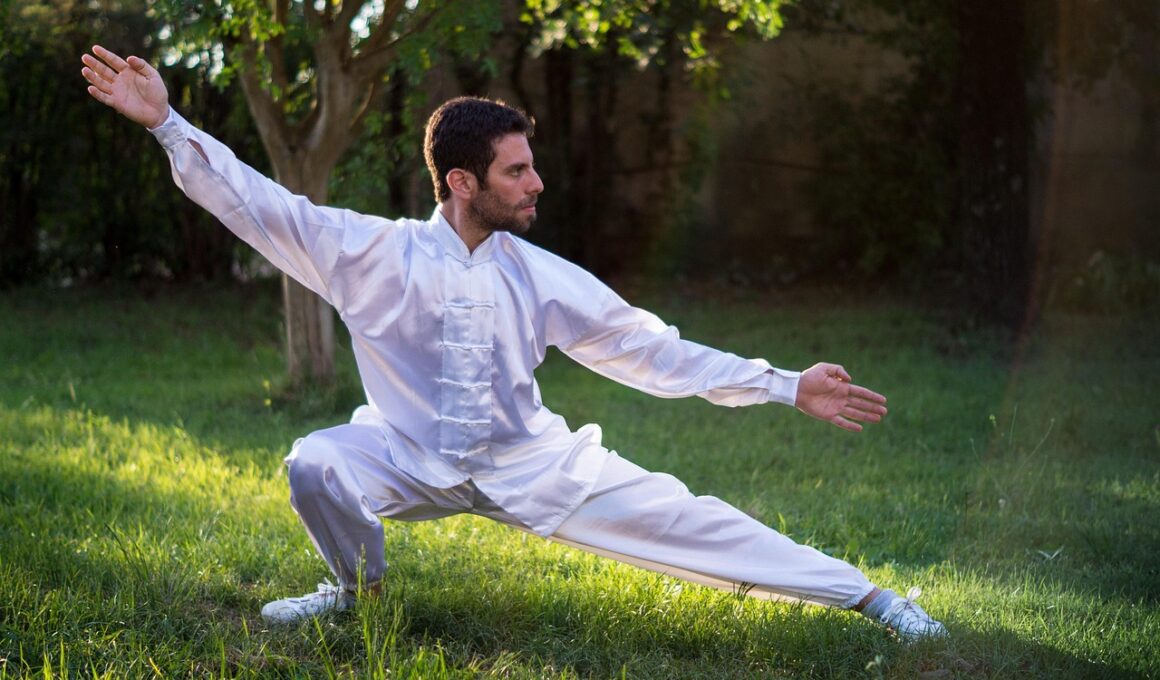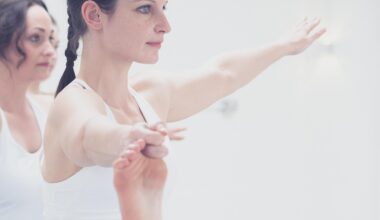How Tai Chi Improves Coordination and Stability
Tai Chi is a form of martial arts that focuses on slow, deliberate movements and mindfulness. Practiced originally for self-defense, it has evolved into a popular exercise for health and wellness, especially among older adults. Tai Chi effectively enhances balance and coordination by emphasizing posture and controlled movements. As practitioners engage in each sequence, they develop better body awareness and spatial orientation, which are crucial for effective movement. Additionally, the mental focus needed in Tai Chi promotes concentration, allowing the mind and body to work together harmoniously. This connection helps to improve the body’s overall stability, reducing the risk of falls and injuries. Moreover, Tai Chi encourages breathing techniques that enhance relaxation and reduce stress, contributing to improved lower body strength and stability. Slow movements activate core muscles, helping to maintain an upright posture. This practice not only benefits physical health but also mental well-being, creating a holistic form of exercise. Many studies indicate a strong link between regular Tai Chi practice and improvements in quality of life for seniors, showcasing its benefits for enhanced coordination and stability.
Benefits of Tai Chi for Balance
Balance is an essential aspect of physical fitness, particularly as we age. Research has shown that Tai Chi significantly improves balance perception in individuals, which is attributed to its gentle, fluid movements. Regular practice allows participants to strengthen their leg muscles, which play a vital role in maintaining balance. Improved strength leads to better control over body movements, resulting in reduced fall rates among older adults. Tai Chi emphasizes weight shifting, which trains the body to stabilize itself in varying conditions. This practice provides not only physical benefits but also enhances proprioception, the sense of body position, which is crucial for coordinated movements. Furthermore, Tai Chi promotes relaxation, reducing tension in the muscles that can lead to instability. Practitioners often report feeling more grounded and secure in their movements. Effective coordination relies on a healthy interplay between strength and awareness. Because Tai Chi is adaptable, people at different fitness levels can participate, making it an excellent choice for group classes or individual practice. Consequently, Tai Chi serves as both a preventive measure and rehabilitation tool for balance enhancement.
One of the remarkable aspects of Tai Chi is its ability to cater to a wide range of physical abilities. Beginners can start with simplified movements, gradually increasing complexity as they build strength and confidence. Instructors typically emphasize proper body alignment and posture, which fosters better coordination and balance. Furthermore, practicing Tai Chi in a group setting provides a supportive environment. Community bond fosters motivation and accountability, essential aspects of any fitness program. As participants watch and mimic each other, they receive immediate feedback on their movement quality. This not only aids in enhancing coordination but also instills a sense of satisfaction and achievement. Many older adults express joy in reconnecting with their physical abilities through Tai Chi. As they practice, their body’s memory of movement patterns improves. This improvement leads to increased stability when performing daily activities, showcasing real-world applications of Tai Chi practice. With consistent effort, individuals become more adept at navigating their environments seamlessly. Thus, Tai Chi can equip practitioners with a toolkit that enhances both coordination and overall movement efficiency.
Improving Mental Focus and Coordination
Mental clarity is another significant benefit of engaging in Tai Chi practice. Tai Chi requires sustained concentration on breathing and movement, which sharpens mental processes. Participants learn to focus on their body’s alignment while directing energy flow, a concept integral to this ancient practice. This meditative aspect of Tai Chi is crucial for reducing distractions, enhancing mental coordination concurrently with physical abilities. Many practitioners find clarity, which contributes positively to coordination. The mindfulness cultivated in Tai Chi allows individuals to become more aware of their movements, preventing accidents caused by inattention or haste. Enhanced spatial awareness and coordination play a vital role in everyday tasks, such as walking and climbing stairs. As students become more attuned to their bodies, their ability to react dynamically and fluidly to environmental changes improves. Additionally, improved mental focus leads to increased overall well-being, reducing feelings of anxiety and depression that can undermine physical health. As enthusiasts share their experiences, they often highlight how Tai Chi helped them maintain an active lifestyle, fostering resilience against the physical challenges of aging.
Incorporating Tai Chi into your routine can be quite straightforward. To maximize benefits, it’s recommended to practice regularly, aiming for at least two to three sessions per week. Individuals may begin with short sessions of just 10-15 minutes, gradually increasing duration and complexity. Perfecting specific movements enhances both balance and coordination. Additionally, there are numerous resources available, such as guided classes and online tutorials, making it accessible for everyone. Content creation on platforms like YouTube and dedicated fitness apps allows for virtual practice at home. Joining local Tai Chi groups provides opportunities to develop social connections while learning. These communities often inspire participants and promote a sense of belonging, essential for long-term adherence to any exercise program. Many participants enjoy sharing their progress and connecting with others. Just like physical health, commitment to a practice often leads to quality outcomes, making consistent participation essential. Practicing regularly not only maximizes physical benefits but serves as a gateway to holistic wellness. Individuals frequently express how Tai Chi transformed their approach to exercise, showcasing its compelling benefits for balance and coordination.
Common Misconceptions About Tai Chi
Despite its age and popularity, several misconceptions about Tai Chi exist. Many individuals perceive it as merely gentle stretching or relaxation therapy; however, it offers more profound strength-building properties. Tai Chi blends elegance with physical power, requiring significant effort, especially in advanced techniques. Some people think Tai Chi is too easy for younger, active adults. Yet, Tai Chi can challenge even the fittest individual, as every movement engages core muscles and requires focus. Other misconceptions arise from viewing Tai Chi only as a pastime for seniors. While it is highly recommended for older adults to aid mobility, its versatility makes it suitable for practitioners of all ages. Moreover, some believe effective Tai Chi requires prior martial arts experience. In reality, beginners can safely learn the practice with guidance and gradually develop proficiency over time. It’s essential to communicate these misconceptions, allowing people to access the full scope of Tai Chi’s benefits. By embracing the practice’s diverse nature, everyone can enjoy its positive impacts on coordination and overall fitness.
In summary, Tai Chi is an invaluable tool for enhancing coordination and stability. The ancient practice combines physical movement with mindfulness, producing both mental and physical benefits. Communities flourish through shared experiences and encouragement among practitioners. The slow, deliberate movements engage the body in a manner that builds strength, flexibility, and balance. As individuals cultivate their skills, they enhance not only their physical capabilities but also their mental clarity, embodying the essence of holistic wellness. The practice is suitable for everyone, from seniors to younger adults seeking improved stability and control. Many participants have successfully integrated Tai Chi into their lifestyles, enjoying the dual benefits of coordination improvement and stress relief. By displacing misconceptions, more people can appreciate Tai Chi’s depth as a rigorous physical workout embedded within a meditative framework. Ultimately, Tai Chi empowers individuals to take charge of their health, fostering resilience against challenges associated with aging. As this practice continues to thrive in modern society, its benefits will inspire generations to improve their balance and coordination effectively.



